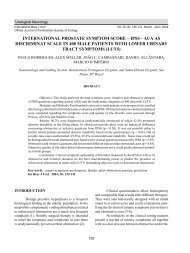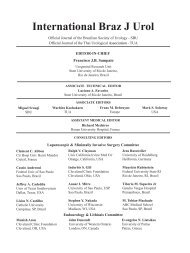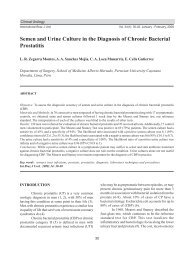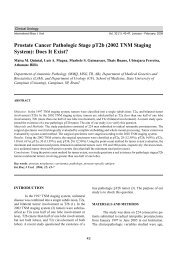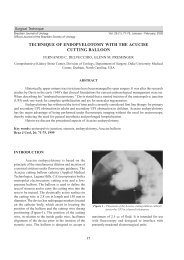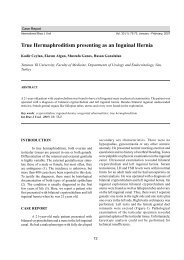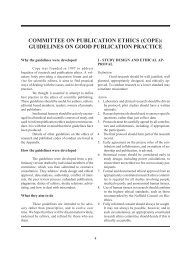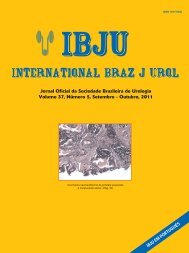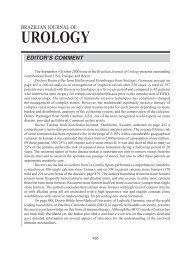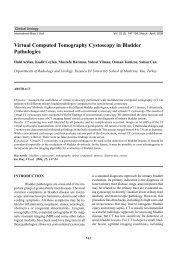Phyllanthus niruri as a Promising Alternative Treatment for ...
Phyllanthus niruri as a Promising Alternative Treatment for ...
Phyllanthus niruri as a Promising Alternative Treatment for ...
Create successful ePaper yourself
Turn your PDF publications into a flip-book with our unique Google optimized e-Paper software.
Review Article<br />
<strong>Phyllanthus</strong> <strong>niruri</strong> <strong>as</strong> <strong>Treatment</strong> <strong>for</strong> Nephrolithi<strong>as</strong>is<br />
International Braz J Urol Vol. 36 (6): 657-664, November - December, 2010<br />
doi: 10.1590/S1677-55382010000600002<br />
<strong>Phyllanthus</strong> <strong>niruri</strong> <strong>as</strong> a <strong>Promising</strong> <strong>Alternative</strong> <strong>Treatment</strong> <strong>for</strong><br />
Nephrolithi<strong>as</strong>is<br />
Mirian A. Boim, Ita P. Heilberg, Nestor Schor<br />
Renal Division, Federal University of Sao Paulo, Unifesp, Sao Paulo, Brazil<br />
ABSTRACT<br />
In spite of considerable ef<strong>for</strong>ts to identify effective treatments <strong>for</strong> urolithi<strong>as</strong>is, this is a goal yet to be achieved. This review<br />
summarizes experimental and clinical data evaluating the effect of the plant <strong>Phyllanthus</strong> <strong>niruri</strong>, a plant with worldwide<br />
distribution, <strong>as</strong> a potential agent to prevent and/or to treat urolithi<strong>as</strong>is The review is b<strong>as</strong>ed on data from the literature and<br />
on the results obtained by our group from either in vivo/in vitro experiments or clinical studies. <strong>Phyllanthus</strong> <strong>niruri</strong> h<strong>as</strong><br />
been shown to interfere with many stages of stone <strong>for</strong>mation, reducing crystals aggregation, modifying their structure and<br />
composition <strong>as</strong> well <strong>as</strong> altering the interaction of the crystals with tubular cells leading to reduced subsequent endocytosis.<br />
The clinical beneficial effects of <strong>Phyllanthus</strong> <strong>niruri</strong> may be related to ureteral relaxation, helping to eliminate calculi or to<br />
clear fragments following lithotripsy, or also to a putative reduction of the excretion of urinary crystallization promoters<br />
such <strong>as</strong> calcium. No adverse renal, cardiov<strong>as</strong>cular, neurological or toxic effects have been detected in either of these studies.<br />
Altogether, these studies suggest a preventive effect of <strong>Phyllanthus</strong> <strong>niruri</strong> in stone <strong>for</strong>mation or elimination, but still<br />
longer-term randomized clinical trials are necessary to confirm its therapeutic properties.<br />
Key words: renal; lithi<strong>as</strong>is; treatment; clinical; <strong>Phyllanthus</strong> <strong>niruri</strong><br />
Int Braz J Urol. 2010; 36: 657-64<br />
INTRODUCTION<br />
Urinary stones affect 10-12% of the population<br />
in industrialized countries. Their incidence h<strong>as</strong><br />
been incre<strong>as</strong>ing over the l<strong>as</strong>t years and the age of<br />
onset is decre<strong>as</strong>ing. In addition, the recurrence rate<br />
is high, more than 50% after 10 years (1,2). Genetic,<br />
metabolic, environmental and dietetic factors are<br />
involved in the pathogenesis of urolithi<strong>as</strong>is, all of<br />
them propitiating the crystallization of salts inside the<br />
renal tubules, further retention and growing to <strong>for</strong>m<br />
a stone (3). Given that urine is normally a supersaturated<br />
solution, crystalluria is often observed in normal<br />
individuals, but if crystals remain apart from each<br />
other, they are w<strong>as</strong>hed away by urine flow. However,<br />
under certain circumstances they bind each other due<br />
to chemical and electrical <strong>for</strong>ces triggering the process<br />
of aggregation. The crystals or aggregates then attach<br />
to the epithelium which allow them to grow further<br />
and <strong>for</strong>m the stone (4). Moreover, calcium oxalate<br />
(CaOx) crystals, the main constituent of human urinary<br />
calculi, may adhere in a specific manner to the<br />
pl<strong>as</strong>ma membrane of epithelial cells and this process<br />
is followed by endocytosis of the crystals resulting<br />
in cell damage or death (5,6). Damaged cells exhibit<br />
a proliferative response, incre<strong>as</strong>e the synthesis of<br />
fibrogenic substances promoting additional stimulus<br />
<strong>for</strong> crystal growth (7,8). In addition, dead cells detach<br />
657
<strong>Phyllanthus</strong> <strong>niruri</strong> <strong>as</strong> <strong>Treatment</strong> <strong>for</strong> Nephrolithi<strong>as</strong>is<br />
from the b<strong>as</strong>ement membrane and the cellular debris<br />
will adhere to other crystals resulting in a stone nidus.<br />
Thus, the cellular pathways involved in endocytosis of<br />
CaOx crystals can constitute potential targets <strong>for</strong> drugs<br />
designed <strong>for</strong> the prophylaxis and/or treatment of urolithi<strong>as</strong>is.<br />
Different substances have been described <strong>as</strong><br />
modulators of adhesion and/or endocytosis processes<br />
(9-11) but none of them seem to be suitable <strong>for</strong> clinical<br />
use. On the other hand, alternative treatments such<br />
<strong>as</strong> the traditional herbal treatments can compliment<br />
pharmacotherapies <strong>for</strong> prevention and/or treatment of<br />
urolithi<strong>as</strong>is with less expense and perhaps fewer side<br />
effects, <strong>as</strong> reviewed by Miyaoka and Monga (12).<br />
We have been evaluating the effects <strong>Phyllanthus</strong><br />
<strong>niruri</strong> on several stages of stone <strong>for</strong>mation <strong>as</strong><br />
well <strong>as</strong> its potential therapeutic potential in lithi<strong>as</strong>ic<br />
patients. Experimental and clinical studies per<strong>for</strong>med<br />
by our group and by others have produced interesting<br />
and hopeful data concerning the potential therapeutic<br />
use of <strong>Phyllanthus</strong> <strong>niruri</strong> to treat and/or to prevent<br />
stone <strong>for</strong>mation. These data are summarized in this<br />
review.<br />
<strong>niruri</strong> may be a potential source of many substances<br />
with antilithi<strong>as</strong>ic properties.<br />
Interestingly, given that the maintenance of<br />
normal levels of calcium is critical to the function<br />
of many plants including plant rigidity, protection,<br />
detoxification (heavy metals or oxalic acid), ion balance<br />
and even light reflection (20), and because high<br />
cellular free calcium concentration may be dangerous<br />
<strong>for</strong> these organisms, higher plants (plants exhibiting<br />
a v<strong>as</strong>cular system) developed a very efficient way<br />
to neutralize Ca+2 ions, by <strong>for</strong>ming complexes with<br />
oxalate (21). Oxalate producing plants, which include<br />
many crop plants, accumulate oxalate and <strong>as</strong> much <strong>as</strong><br />
90% of the total calcium in the <strong>for</strong>m of CaOx crystals.<br />
Curiously, <strong>as</strong> shown in Figure-1, refractive CaOx<br />
crystals seen in the leaves of <strong>Phyllanthus</strong> <strong>niruri</strong> are<br />
kept equidistant, do not aggregate hence not <strong>for</strong>ming<br />
stones. There<strong>for</strong>e, understanding the b<strong>as</strong>ic molecular<br />
strategies by which some plants are able to package<br />
CaOx crystals may provide insights into the potential<br />
utilization of these plants to prevent/treat urolithi<strong>as</strong>is<br />
(22).<br />
PHYLLANTHUS NIRURI<br />
<strong>Phyllanthus</strong> <strong>niruri</strong>, popularly known <strong>as</strong><br />
“stone-breaker” (“quebra-pedr<strong>as</strong>”) is a plant belonging<br />
to the Euphorbiaceae family with a worldwide<br />
distribution and it is used in folk Brazilian medicine<br />
<strong>for</strong> patients with urolithi<strong>as</strong>is (13). More than 50<br />
compounds were identified in the <strong>Phyllanthus</strong> <strong>niruri</strong>,<br />
including alkaloids, flavanoids, lignans and triterpenes<br />
(14). Among these substances, the triterpenes have<br />
been found to inhibit the cytotoxicity induced by<br />
calcium oxalate (15) <strong>as</strong> well <strong>as</strong> to reduce excretion<br />
of stone <strong>for</strong>ming constituents (16) and the markers<br />
of crystal deposition in the kidneys (17). Moreover,<br />
methanol extract from the leaves of <strong>Phyllanthus</strong> <strong>niruri</strong><br />
containing substances such <strong>as</strong> lignans and phyllanthin<br />
showed a uricosuric activity in hyperuricemic rats<br />
(18). According to Calixto et al. (19) alkaloids extracted<br />
from plants of the genus <strong>Phyllanthus</strong> present<br />
an antisp<strong>as</strong>modic activity leading to smooth muscle<br />
relaxation, mostly evidenced in the urinary tract,<br />
which would facilitate the elimination of urinary<br />
calculi. These data strongly suggest that <strong>Phyllanthus</strong><br />
IN VITRO STUDIES<br />
The effect of the aqueous extract of <strong>Phyllanthus</strong><br />
<strong>niruri</strong> on crystallization process of CaOx in<br />
human urine h<strong>as</strong> also been investigated in a model of<br />
in vitro precipitation of CaOx in human urine (23).<br />
Barros et al. (24) observed that the pre-incubation of<br />
Figure 1 – CaOx crystals observed in <strong>Phyllanthus</strong> <strong>niruri</strong> leaves<br />
observed under light microscopy.<br />
658
<strong>Phyllanthus</strong> <strong>niruri</strong> <strong>as</strong> <strong>Treatment</strong> <strong>for</strong> Nephrolithi<strong>as</strong>is<br />
human urine with <strong>Phyllanthus</strong> <strong>niruri</strong> did not inhibit<br />
the precipitation of CaOx particles and even more<br />
crystals were obtained in <strong>Phyllanthus</strong> <strong>niruri</strong>-containing<br />
urine, but the crystals were proportionally smaller<br />
than those in urine samples without <strong>Phyllanthus</strong><br />
<strong>niruri</strong>. Moreover, they observed that after 24 hours,<br />
the precipitated crystals <strong>for</strong>med large agglomerates in<br />
untreated urine, but the crystals remained dispersed in<br />
urine with <strong>Phyllanthus</strong> <strong>niruri</strong> (Figure-2). The authors<br />
concluded that <strong>Phyllanthus</strong> <strong>niruri</strong> did not decre<strong>as</strong>e the<br />
number of crystals but induced a marked reduction of<br />
particle size and crystal aggregation. Similar results<br />
were obtained by Atmani E and Khan SR (25) employing<br />
a different plant species (Herniaria hirsute), which<br />
is used in folk medicine in the Mediterranean area <strong>for</strong><br />
its diuretic properties and to treat kidney stones. Crystalluria<br />
is a common event observed even in non-stone<br />
<strong>for</strong>ming individuals. CaOx crystals are found in urine<br />
under several <strong>for</strong>ms including monohydrate (COM)<br />
and dihydrate (COD) <strong>for</strong>ms. Unlike COD, which is<br />
predominantly found in normal individuals, COM<br />
crystals have higher capacity to aggregate and adhere,<br />
and is the main <strong>for</strong>m excreted by the nephrolithi<strong>as</strong>is<br />
patients (26-28). In the model of in vitro precipitation<br />
of CaOx using human urine from healthy individuals,<br />
<strong>Phyllanthus</strong> <strong>niruri</strong> induced an incre<strong>as</strong>e in COD <strong>for</strong>ms<br />
and reduced the amount of COM crystals, responsible<br />
<strong>for</strong> higher potential risk <strong>for</strong> stone <strong>for</strong>mation.<br />
Besides CaOx crystallization, it h<strong>as</strong> been<br />
shown that the methanol extracts of <strong>Phyllanthus</strong><br />
<strong>niruri</strong> showed an inhibitory activity of the enzyme<br />
xanthine oxid<strong>as</strong>e in vitro (29) which w<strong>as</strong> attributed<br />
to compounds such <strong>as</strong> flavonoids, polyphenols and<br />
tannins (30,31). There<strong>for</strong>e, together with its uricosuric<br />
property (18), this enzymatic inhibition activity makes<br />
<strong>Phyllanthus</strong> <strong>niruri</strong> a potential antihyperuricemic<br />
agent.<br />
STUDIES IN CULTURED CELLS<br />
Campos and Schor (32) have demonstrated<br />
that <strong>Phyllanthus</strong> <strong>niruri</strong> exhibited a potent inhibitory<br />
effect on CaOx crystal adhesion and/or endocytosis<br />
Figure 2 – Light microscopy of CaOx crystals <strong>for</strong>med immediately (0 hr) and 24 hours after the addition of sodium oxalate solution in<br />
normal human urine and after in the absence and presence of <strong>Phyllanthus</strong> <strong>niruri</strong>. X100 and X400.<br />
659
<strong>Phyllanthus</strong> <strong>niruri</strong> <strong>as</strong> <strong>Treatment</strong> <strong>for</strong> Nephrolithi<strong>as</strong>is<br />
by an immortalized cell line derived from canine<br />
kidney (MDCK cells) representative of the medullar<br />
collecting duct. This type of inhibitory effect occurred<br />
even when high doses (2.5 to 5-fold the upper limit<br />
in human urine) of CaOx have been employed and<br />
without causing cell toxicity.<br />
EXPERIMENTAL MODELS IN RATS<br />
The effect of <strong>Phyllanthus</strong> <strong>niruri</strong> h<strong>as</strong> also been<br />
evaluated in experimental models of urolithi<strong>as</strong>is in<br />
rats, mainly those induced by implantation of a calcium<br />
oxalate (CaOx) crystal into the bladder (vesical<br />
<strong>for</strong>eign body method). This experimental model of<br />
urolithi<strong>as</strong>is is obtained with no significant metabolic<br />
or systemic alterations and the vesical CaOx seed acts<br />
<strong>as</strong> a supporting surface allowing organic and inorganic<br />
material to precipitate over the central nidus, mimicking<br />
a spontaneous calculus growth. It w<strong>as</strong> initially<br />
shown that rats drinking <strong>Phyllanthus</strong> <strong>niruri</strong> tea ad<br />
libitum, presented decre<strong>as</strong>ed rate of stone growth (33).<br />
These effects occurred independently of any relevant<br />
modification in the urinary excretion of elements<br />
known to promote crystallization and stone <strong>for</strong>mation,<br />
including calcium, oxalate, uric acid, pH, etc. In order<br />
to evaluate if the beneficial effect of <strong>Phyllanthus</strong> <strong>niruri</strong><br />
could be mediated by modifications of the inhibitors<br />
of stone <strong>for</strong>mation, such <strong>as</strong> citrate, magnesium and/or<br />
glycosaminoglycans, Freit<strong>as</strong> et al. (34) administered<br />
1.25 mg/mL/day of <strong>Phyllanthus</strong> <strong>niruri</strong> <strong>for</strong> 42 days in<br />
rats with vesical CaOx seed. This chronic treatment<br />
induced a significant reduction in the calculi growth,<br />
in the absence of any modification in the volume<br />
diuresis or alterations in the urinary concentration of<br />
lithogenic elements including calcium and oxalate.<br />
<strong>Phyllanthus</strong> <strong>niruri</strong> administration did not modify the<br />
urinary excretion of citrate and magnesium, indicating<br />
that the putative antilithogenic effect of <strong>Phyllanthus</strong><br />
<strong>niruri</strong> w<strong>as</strong> not primarily mediated by modifications<br />
in these inhibitors. In contr<strong>as</strong>t, it w<strong>as</strong> observed that<br />
<strong>Phyllanthus</strong> <strong>niruri</strong> induced a decre<strong>as</strong>e in the urinary<br />
excretion of glycosaminoglycans (GAGs) compared<br />
with lithi<strong>as</strong>ic animals receiving water. In contr<strong>as</strong>t, the<br />
content of GAGs w<strong>as</strong> higher in calculi taken from<br />
treated animals suggesting that the inhibitory effect<br />
<strong>Phyllanthus</strong> <strong>niruri</strong> on crystal growth might have been<br />
related to higher incorporation of GAGs into the<br />
calculi. The adsorption of these macromolecules into<br />
the calculi lead to stones with a predominant intracrystalline<br />
amorphous organic matrix. Taken together,<br />
these results suggested that <strong>Phyllanthus</strong> <strong>niruri</strong> w<strong>as</strong><br />
able to prevent the aggregation of calcium oxalate to<br />
the pre-existent crystal without interfering with the<br />
incorporation of GAGs into organic matrix. Although<br />
the underlying mechanism remains to be clarified,<br />
some possible hypotheses can be raised: 1) a neutralization<br />
of negative charges of GAGs reduced the<br />
negative pole <strong>for</strong> progressive deposition of cations; 2)<br />
active components of the plant could have chelated<br />
and/or competed with calcium <strong>for</strong> binding sites on the<br />
crystal surface; 3) effects of <strong>Phyllanthus</strong> <strong>niruri</strong> itself<br />
on other proteins including Tamm-Horsfall protein,<br />
nephrocalcin, osteopontin, prothrombin fragment 1,<br />
etc, modulating crystallization, aggregation and calculi<br />
growth and 4) <strong>Phyllanthus</strong> <strong>niruri</strong> could reduce the<br />
crystal adhesion to the tubular epithelium. Essentially,<br />
these results suggest that <strong>Phyllanthus</strong> <strong>niruri</strong> could<br />
interfere with the calculi growth or prevent stone<br />
<strong>for</strong>mation rather than dissolving pre-<strong>for</strong>med stones.<br />
In order to better mimic what is observed<br />
in clinical practice, Barros et al. (35) using a vesical<br />
<strong>for</strong>eign body model in rats, compared the efficacy of<br />
<strong>Phyllanthus</strong> <strong>niruri</strong> treatment started concomitantly<br />
with CaOx seed implantation with the same treatment<br />
started 30 days after the seed implantation (when the<br />
vesical calculus w<strong>as</strong> completely <strong>for</strong>med). As represented<br />
in Figure-3, the early treatment (Figure-3A)<br />
caused a significant inhibition in the calculi growth<br />
compared with non-treated animals (Figure-3B), <strong>as</strong><br />
previously observed (34). In contr<strong>as</strong>t, the treatment<br />
initiated after the stone <strong>for</strong>mation, did not prevent<br />
the calculi to grow further neither propitiated calculi<br />
elimination; however it induced dr<strong>as</strong>tic changes in<br />
the shape and texture of the pre<strong>for</strong>med calculi (Figure-3C).<br />
Stones taken from <strong>Phyllanthus</strong> <strong>niruri</strong> treated<br />
animals were more homogeneous and contained more<br />
compact surfaces (Figures 3D and 3E) in contr<strong>as</strong>t<br />
to the spicule-shaped surface taken from untreated<br />
animals (Figure-3F). This result suggests that <strong>Phyllanthus</strong><br />
<strong>niruri</strong> probably interferes with the biomineralization<br />
process, by promoting a different interaction<br />
between the crystal and the macromolecules of the<br />
organic matrix. Although <strong>Phyllanthus</strong> <strong>niruri</strong> had not<br />
660
<strong>Phyllanthus</strong> <strong>niruri</strong> <strong>as</strong> <strong>Treatment</strong> <strong>for</strong> Nephrolithi<strong>as</strong>is<br />
A B C<br />
D E F<br />
Figure 3 – Upper and lower panels show the stereomicroscopy and scanning electronic microscopy respectively of the calculi taken<br />
from animals untreated (A and D), animals treated from the beginning (B and E) and from later treated animals (C and F).<br />
prevented the calculi growth, the treatment resulted<br />
in the <strong>for</strong>mation of calculi with smoother surfaces,<br />
which could at le<strong>as</strong>t, contribute to less painful calculi<br />
voiding.<br />
CLINICAL STUDIES<br />
The initial study (33) addressing the effects<br />
of the <strong>Phyllanthus</strong> <strong>niruri</strong> administered in the <strong>for</strong>m<br />
of tea did not demonstrate any clinical or biochemical<br />
adverse effects (cardiov<strong>as</strong>cular, renal, hepatic or<br />
neurological) even at high dosage, with excellent<br />
tolerability in healthy volunteers. In addition, tea consumption<br />
in the same dose by nephrolithi<strong>as</strong>is patients<br />
<strong>for</strong> a period of 3 months, led to an apparent incre<strong>as</strong>ed<br />
elimination of calculi compared to patients drinking<br />
placebo. These results were probably <strong>as</strong>cribed to the<br />
antisp<strong>as</strong>modic and relaxant effects of <strong>Phyllanthus</strong><br />
<strong>niruri</strong> upon ureteral muscle, facilitating calculi voiding.<br />
Subsequently, another study by Nishiura et<br />
al. (36), also in our Service, evaluated the effect of a<br />
lyophilized 2% aqueous extract of <strong>Phyllanthus</strong> <strong>niruri</strong>,<br />
in an additional series of 69 lithi<strong>as</strong>ic patients in the<br />
<strong>for</strong>m of 450 mg capsules (three times a day) compared<br />
with placebo (Chicorium sativum). In this short-term<br />
follow-up conducted during a three-months period,<br />
no significant differences in calculi voiding and/or<br />
pain relief between the groups taking <strong>Phyllanthus</strong><br />
<strong>niruri</strong> or the placebo were detected. However, <strong>as</strong><br />
patients were cl<strong>as</strong>sified according to the presence of<br />
metabolic disturbance, a significant reduction in the<br />
mean urinary calcium excretion w<strong>as</strong> observed only<br />
among hypercalciuric patients. The phytochemical<br />
and pharmacological properties of this plant have<br />
been accounted <strong>for</strong> the action of different substances<br />
such <strong>as</strong> Rutin, beta-amylin, beta-sitosterol, caffeic<br />
acid, geranin, quercetin, niruside and repandusinic<br />
acid. Although none of these compounds h<strong>as</strong> been<br />
shown to have an effect on calciuria to date, such<br />
potential beneficial effect of <strong>Phyllanthus</strong> <strong>niruri</strong> <strong>for</strong><br />
hypercalciuric patients needs to be further confirmed<br />
in longer-term studies involving a higher number of<br />
subjects.<br />
Micali and coworkers (37) observed that<br />
patients submitted to extracorporeal shock wave<br />
lithotripsy and treated with <strong>Phyllanthus</strong> <strong>niruri</strong> during<br />
661
<strong>Phyllanthus</strong> <strong>niruri</strong> <strong>as</strong> <strong>Treatment</strong> <strong>for</strong> Nephrolithi<strong>as</strong>is<br />
Table 1 – Summary of main findings.<br />
Studies Main Findings Reference<br />
Models in vitro<br />
Models in vivo<br />
Clinical<br />
Inhibition of CaOx crystal adhesion and/or endocytosis<br />
Reduction in crystals aggregation<br />
Incre<strong>as</strong>e in COD <strong>for</strong>ms and reduced COM crystals<br />
Decre<strong>as</strong>ed rate of stone growth<br />
Incre<strong>as</strong>e intracrystalline amorphous organic matrix<br />
Changes in the shape and texture of the pre<strong>for</strong>med calculi<br />
Incre<strong>as</strong>ed calculi voiding<br />
Reduction in urinary calcium excretion in hypercalciuric patients<br />
Reduction in residual stone fragments after extracorporeal shock<br />
wave lithotripsy<br />
32<br />
24<br />
24<br />
34,35<br />
34<br />
35<br />
33<br />
36<br />
37<br />
COM = calcium oxalate monohydrate; COD = calcium oxalate dihydrate.<br />
3 months presented lower incidence of residual stone<br />
fragments, mainly those in lower calyceal location<br />
compared with non-treated patients. According to<br />
these investigators, the efficacy and the lack of side<br />
effects of <strong>Phyllanthus</strong> help improve overall outcomes<br />
after extracorporeal shock wave lithotripsy and could<br />
be useful <strong>as</strong> either an alternative or an adjunctive<br />
therapy in the treatment of urolithi<strong>as</strong>is.<br />
Table-1 summarizes the main findings in<br />
all studies. Given the experimental characteristic of<br />
these studies, except <strong>for</strong> the clinical ones (Grade of<br />
recommendation B), an exact level of evidence is not<br />
applicable.<br />
CONCLUSION AND PERSPECTIVES<br />
The experimental studies summarized here<br />
suggest that <strong>Phyllanthus</strong> <strong>niruri</strong> might interfere with<br />
important steps of the calculi <strong>for</strong>mation including<br />
crystal aggregation and internalization by the tubular<br />
cells, crystal structure and composition. These properties<br />
of <strong>Phyllanthus</strong> <strong>niruri</strong> may constitute an important<br />
advantage in the prevention of lithi<strong>as</strong>is, inhibiting<br />
calculus growth and keeping the crystals dispersed<br />
in the urine, with their consequent e<strong>as</strong>ier elimination.<br />
Although clinical studies are less abundant, available<br />
data point to beneficial effects of <strong>Phyllanthus</strong> by inducing<br />
ureteral relaxation, interfering in the excretion<br />
of promoters of urinary crystallization such <strong>as</strong> calcium<br />
or helping to clear fragments following lithotripsy. It<br />
is important to consider however, that although it is<br />
clear that <strong>Phyllanthus</strong> <strong>niruri</strong> can interfere with many<br />
steps of the stone <strong>for</strong>mation, longer-term clinical studies<br />
are necessary to define whether these effects can<br />
be translated into real clinical benefit to treat and/or<br />
prevent urolithi<strong>as</strong>is.<br />
CONFLICT OF INTEREST<br />
REFERENCES<br />
None declared.<br />
1. Moe OW: Kidney stones: pathophysiology and medical<br />
management. Lancet. 2006; 367: 333-44.<br />
2. Bartoletti R, Cai T, Mondaini N, Melone F, Travaglini<br />
F, Carini M, et al.: Epidemiology and risk factors in<br />
urolithi<strong>as</strong>is. Urol Int. 2007; 79(suppl) 1: 3-7.<br />
3. Pak CY, Resnick MI, Preminger GM: Ethnic and<br />
geographic diversity of stone dise<strong>as</strong>e. Urology. 1997;<br />
50: 504-7.<br />
4. Matlaga BR, Coe FL, Evan AP, Lingeman JE: The role<br />
of Randall’s plaques in the pathogenesis of calcium<br />
stones. J Urol. 2007; 177: 31-8.<br />
5. Kh<strong>as</strong>khali MH, Byer KJ, Khan SR: The effect of calcium<br />
on calcium oxalate monohydrate crystal-induced<br />
renal epithelial injury. Urol Res. 2009; 37: 1-6.<br />
662
<strong>Phyllanthus</strong> <strong>niruri</strong> <strong>as</strong> <strong>Treatment</strong> <strong>for</strong> Nephrolithi<strong>as</strong>is<br />
6. Khan SR, Byer KJ, Thamilselvan S, Hackett RL, Mc-<br />
Cormack WT, Benson NA, et al.: Crystal-cell interaction<br />
and apoptosis in oxalate-<strong>as</strong>sociated injury of renal<br />
epithelial cells. J Am Soc Nephrol. 1999; 10(Suppl)<br />
14: S457-63.<br />
7. Lieske JC, Toback FG: Renal cell-urinary crystal<br />
interactions. Curr Opin Nephrol Hypertens. 2000; 9:<br />
349-55.<br />
8. Lieske JC, Toback FG: Interaction of urinary crystals<br />
with renal epithelial cells in the pathogenesis of nephrolithi<strong>as</strong>is.<br />
Semin Nephrol. 1996; 16: 458-73.<br />
9. Tsujihata M, Yoshimura K, Tsujikawa K, Tei N,<br />
Okuyama A: Fibronectin inhibits endocytosis of calcium<br />
oxalate crystals by renal tubular cells. Int J Urol.<br />
2006; 13: 743-6.<br />
10. Campos AH, Schor N: Mechanisms involved in<br />
calcium oxalate endocytosis by Madin-Darby canine<br />
kidney cells. Braz J Med Biol Res. 2000; 33: 111-8.<br />
11. Lieske JC, Huang E, Toback FG: Regulation of renal<br />
epithelial cell affinity <strong>for</strong> calcium oxalate monohydrate<br />
crystals. Am J Physiol Renal Physiol. 2000; 278: F130-<br />
7.<br />
12. Miyaoka R, Monga M: Use of traditional Chinese<br />
medicine in the management of urinary stone dise<strong>as</strong>e.<br />
Int Braz J Urol. 2009; 35: 396-405.<br />
13. Kieley S, Dwivedi R, Monga M: Ayurvedic medicine<br />
and renal calculi. J Endourol. 2008; 22: 1613-6.<br />
14. Bagalkotkar G, Sagineedu SR, Saad MS, Stansl<strong>as</strong> J:<br />
Phytochemicals from <strong>Phyllanthus</strong> <strong>niruri</strong> Linn. and<br />
their pharmacological properties: a review. J Pharm<br />
Pharmacol. 2006; 58: 1559-70.<br />
15. Malini MM, Lenin M, Varalakshmi P: Protective effect<br />
of triterpenes on calcium oxalate crystal-induced<br />
peroxidative changes in experimental urolithi<strong>as</strong>is.<br />
Pharmacol Res. 2000; 41: 413-8.<br />
16. Vidya L, Lenin M, Varalakshmi P: Evaluation of the<br />
effect of triterpenes on urinary risk factors of stone<br />
<strong>for</strong>mation in pyridoxine deficient hyperoxaluric rats.<br />
Phytother Res. 2002; 16: 514-8.<br />
17. Vidya L, Malini MM, Varalakshmi P: Effect of pentacyclic<br />
triterpenes on oxalate-induced changes in rat<br />
erythrocytes. Pharmacol Res. 2000; 42: 313-6.<br />
18. Murugaiyah V, Chan KL: Antihyperuricemic lignans<br />
from the leaves of <strong>Phyllanthus</strong> <strong>niruri</strong>. Planta Med.<br />
2006; 72: 1262-7.<br />
19. Calixto JB, Santos AR, Cechinel Filho V, Yunes RA:<br />
A review of the plants of the genus <strong>Phyllanthus</strong>: their<br />
chemistry, pharmacology, and therapeutic potential.<br />
Med Res Rev. 1998; 18: 225-58.<br />
20. Franceschi V: Calcium oxalate in plants. Trends Plant<br />
Sci. 2001; 6: 331.<br />
21. Franceschi VR, Nakata PA: Calcium oxalate in plants:<br />
<strong>for</strong>mation and function. Annu Rev Plant Biol. 2005;<br />
56: 41-71.<br />
22. Ryall RL: The future of stone research: rummagings in<br />
the attic, Randall’s plaque, nanobacteria, and lessons<br />
from phylogeny. Urol Res. 2008; 36: 77-97.<br />
23. Buchholz NP, Kim DS, Grover PK, Dawson CJ, Ryall<br />
RL: The effect of warfarin therapy on the charge<br />
properties of urinary prothrombin fragment 1 and<br />
crystallization of calcium oxalate in undiluted human<br />
urine. J Bone Miner Res. 1999; 14: 1003-12.<br />
24. Barros ME, Schor N, Boim MA: Effects of an aqueous<br />
extract from Phyllantus <strong>niruri</strong> on calcium oxalate<br />
crystallization in vitro. Urol Res. 2003; 30: 374-9.<br />
25. Atmani F, Slimani Y, Mimouni M, Aziz M, Hacht B,<br />
Ziyyat A: Effect of aqueous extract from Herniaria<br />
hirsuta L. on experimentally nephrolithi<strong>as</strong>ic rats. J<br />
Ethnopharmacol. 2004; 95: 87-93.<br />
26. Dyer R, Nordin BE: Urinary crystals and their relation<br />
to stone <strong>for</strong>mation. Nature. 1967; 215: 751-2.<br />
27. Sheng X, Ward MD, Wesson JA: Crystal surface adhesion<br />
explains the pathological activity of calcium<br />
oxalate hydrates in kidney stone <strong>for</strong>mation. J Am Soc<br />
Nephrol. 2005; 16: 1904-8.<br />
28. Wesson JA, Ward MD: Role of crystal surface adhesion<br />
in kidney stone dise<strong>as</strong>e. Curr Opin Nephrol Hypertens.<br />
2006; 15: 386-93.<br />
29. Murugaiyah V, Chan KL: Mechanisms of antihyperuricemic<br />
effect of <strong>Phyllanthus</strong> <strong>niruri</strong> and its lignan<br />
constituents. J Ethnopharmacol. 2009; 124: 233-9.<br />
30. Cos P, Ying L, Calomme M, Hu JP, Cimanga K, Van<br />
Poel B, et al.: Structure-activity relationship and<br />
cl<strong>as</strong>sification of flavonoids <strong>as</strong> inhibitors of xanthine<br />
oxid<strong>as</strong>e and superoxide scavengers. J Nat Prod. 1998;<br />
61: 71-6.<br />
31. Hatano T, Y<strong>as</strong>uhara T, Yoshihara R, Agata I, Noro T,<br />
Okuda T: Effects of interaction of tannins with coexisting<br />
substances. VII. Inhibitory effects of tannins<br />
and related polyphenols on xanthine oxid<strong>as</strong>e. Chem<br />
Pharm Bull (Tokyo). 1990; 38: 1224-9.<br />
32. Campos AH, Schor N: <strong>Phyllanthus</strong> <strong>niruri</strong> inhibits<br />
calcium oxalate endocytosis by renal tubular cells: its<br />
role in urolithi<strong>as</strong>is. Nephron. 1999; 81: 393-7.<br />
33. Santos DR: Produtos Naturais no Tratamento da Nefrolití<strong>as</strong>e.<br />
In: Schor N (ed.), Calculose Renal: Fisiopatologia,<br />
Diagnóstico e Tratamento. São Paulo, Ed.<br />
Sarvier. 1995; pp. 221-5.<br />
34. Freit<strong>as</strong> AM, Schor N, Boim MA: The effect of <strong>Phyllanthus</strong><br />
<strong>niruri</strong> on urinary inhibitors of calcium oxalate<br />
crystallization and other factors <strong>as</strong>sociated with renal<br />
stone <strong>for</strong>mation. BJU Int. 2002; 89: 829-34.<br />
663
<strong>Phyllanthus</strong> <strong>niruri</strong> <strong>as</strong> <strong>Treatment</strong> <strong>for</strong> Nephrolithi<strong>as</strong>is<br />
35. Barros ME, Lima R, Mercuri LP, Matos JR, Schor<br />
N, Boim MA: Effect of extract of <strong>Phyllanthus</strong><br />
<strong>niruri</strong> on crystal deposition in experimental urolithi<strong>as</strong>is.<br />
Urol Res. 2006; 34: 351-7.<br />
36. Nishiura JL, Campos AH, Boim MA, Heilberg IP,<br />
Schor N: <strong>Phyllanthus</strong> <strong>niruri</strong> normalizes elevated<br />
urinary calcium levels in calcium stone <strong>for</strong>ming<br />
(CSF) patients. Urol Res. 2004; 32: 362-6.<br />
37. Micali S, Sighinolfi MC, Celia A, De Stefani S,<br />
Grande M, Cicero AF, et al.: Can <strong>Phyllanthus</strong><br />
<strong>niruri</strong> affect the efficacy of extracorporeal shock<br />
wave lithotripsy <strong>for</strong> renal stones? A randomized,<br />
prospective, long-term study. J Urol. 2006; 176:<br />
1020-2.<br />
Accepted after revision:<br />
May 26, 2010<br />
Correspondence address:<br />
Dr. Mirian A. Boim<br />
Renal Division, UNIFESP<br />
Rua Botucatu, 740<br />
04023-900, São Paulo, SP, Brazil<br />
Fax: + 55 11 5904-1684<br />
E-mail: mirian@nefro.epm.br<br />
EDITORIAL COMMENT<br />
The authors provide a nice review on the herb<br />
<strong>Phyllanthus</strong> <strong>niruri</strong> whose properties appear in fact to<br />
be promising <strong>as</strong>sets in stone dise<strong>as</strong>e prevention and<br />
treatment. However, care must be taken to properly<br />
design future clinical studies in a way to provide reliable,<br />
consistent and reproducible data. As a major<br />
concern, I would point out the definition of accurate<br />
dosage and mode of intake. In a recent review on Chinese<br />
herbs used <strong>for</strong> managing stone dise<strong>as</strong>e, Miyaoka<br />
et al. (1) found several clinical trials demonstrating the<br />
likely benefits on stone prevention. However, the lack<br />
of standardization on dose and compounds between<br />
studies evaluating the same herbs made it extremely<br />
difficult to compare them and draw a sustainable<br />
conclusion. As a result, although used <strong>for</strong> hundreds<br />
of years with practical evidence of clinical benefits,<br />
Chinese herbs still strive to enter the armamentarium<br />
of stone therapy <strong>as</strong> a global consensus.<br />
REFERENCE<br />
1. Miyaoka R, Monga M: Use of traditional Chinese<br />
medicine in the management of urinary stone dise<strong>as</strong>e.<br />
Int Braz J Urol. 2009; 35: 396-405.<br />
Dr. Ricardo Miyaoka<br />
Division of Urology<br />
University of Campin<strong>as</strong>, UNICAMP<br />
Campin<strong>as</strong>, SP, Brazil<br />
E-mail: rmiyaoka@uol.com.br<br />
664



